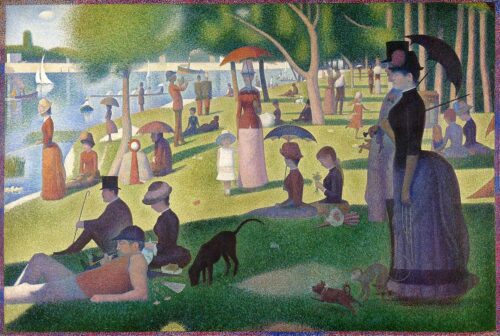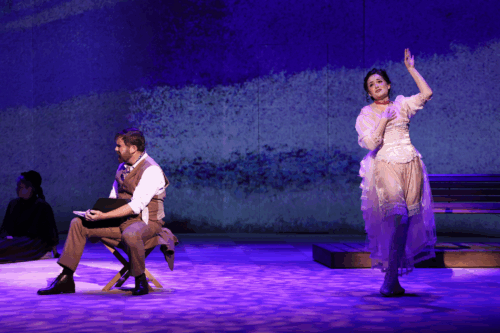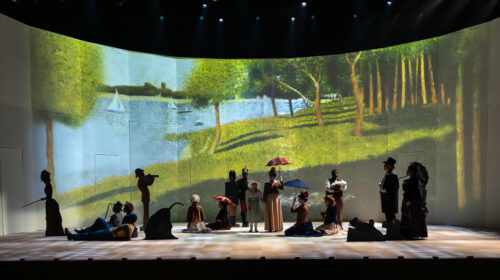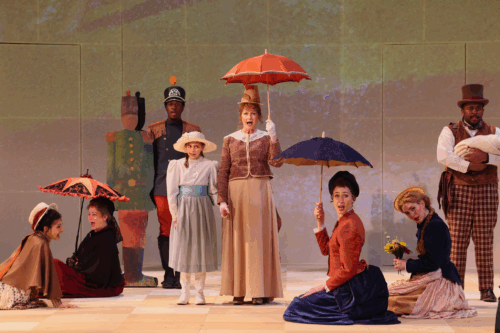From the Nashville Repertory Theatre
Sunday in the Park with George
I had been looking forward to this show since they’d first announced it. Sondheim! Sunday in the Park with George won the 1985 Pulitzer Prize for Drama (one of only 10 musicals to do so). I won’t go into deep analysis of the musical itself; there are many excellent resources on this work, both online and especially in James Lapine’s book Putting It Together: How Stephen Sondheim and I created Sunday in the Park with George. You can also watch the PBS American Playhouse version with most of the original cast on YouTube and elsewhere. Except for a brief summary of the musical, I will focus my review on the Nashville Repertory Theatre’s production. 
In the past few years I’ve seen the Nashville Repertory Theatre do many excellent musicals with the typical clear-cut separation of dialogue and individual songs. Sunday in the Park with George, however, has lengthy stream-of-consciousness songs with interspersed dialogue, complex rhythms, challenging vocal demands, and talented musicians. You can’t accomplish this show casually or half-heartedly. The Nashville Rep did it with complete dedication. It was an impressive and successful accomplishment.
The musical is about two-and-a-half hours with two acts. The first act is about Georges Seurat and his meticulous creation of the famous and familiar pointillist painting A Sunday Afternoon on the Island of La Grande Jette. This took the real artist two years to make and around 60 different studies and sketches. We see how his obsession with his creation damages his relationships while also enjoying large comic scenes with the ensemble who together make up the figures in the final painting. The second act is about his fictional descendent and his own artistic career in 1984, struggling with some of the same issues as his ancestor. The play muses on the nature of the creation of art, the art world, authenticity, and community with others.

I saw their April 11th show with a highly engaged crowd. While the Nashville Rep always has great musicians (thank you Music City), this group was strikingly good. Taking on the demanding music, the orchestra was fantastic, playing nonstop and fluidly under Stephen Kummer’s direction. With the full orchestration of the original score we were able to enjoy the musical in its complete glory. All the textures and uniquely chosen timbres were perfectly balanced with the voices of the singers in Polk Hall, showcasing the skill of the Rep and the aptness of the space for musicals.
The singing was excellent, the cast completed their roles with vocal skill and tight ensemble collaboration. The accomplished Broadway performer Christine Dwyer was stunning as Dot, George’s mistress and eventually mother of his child, immediately winning us over in the opening number “Sunday in the Park with George.” Not only her voice, but her acting and knack for comedy were excellent. David Shannon, experienced in London’s West End, showed the complexities of George through his talented performance.
This opening number also holds a challenge: for most of the song Dot is complaining about modeling on a hot day until a new musical theme is introduced and she sings her intimate thoughts about George and herself, before returning to her complaining. The original show doesn’t only express through the music, but has her literally step out of her dress for the moment of intimacy. The “iron dress” remains standing in the rigid pose and she returns to it when she resumes her complaints about posing. It’s an unexpected and deeply funny expression of costume design meeting the music. The 2017 Broadway revival production dropped this element, having Dot instead step away from an upright parasol and remove her jacket. While this communicates much the same thing and is easy to accomplish, the Nashville Rep didn’t go the easy road. Costume Designer Melissa K. Durmon took on the challenge and provided the iron dress to audience delight. Since the various members of the ensemble comprise different figures in the final painting, most of the costumes were determined in 1886, but Durmon did a marvelous job of providing the details and fitting them perfectly to the cast.
As a musical about a man’s obsession with the creation of a painting, it’s rather important to be able to see the painting. The visuals of this show were excellent: a neutral-colored backdrop became a projector screen to showcase Seurat’s painting. For the first act the background was a projected image of one of Seurat’s many studies for the painting. It’s colorful and beautiful and of the actual location. Gary C. Hoff’s design was perfect! Characters often find themselves exactly where they will be in the final painting. The hugeness of the backdrop made it so that everyone in the audience had the perfect sightline to see their placement.
There are a few moments in the first act when we see George in his studio, and large picture frames with transparent screens are lowered. Images of the paintings he’s working on are projected onto these, literally allowing us to see George through his art. A great visual gag at the beginning of the play calls for the removal of a tree George dislikes while sketching, and the prop is lifted from the stage up out of sight.
The second act, where George’s great-great-grandson’s own art is a “Chromolume” was somewhat less impressive than the original production’s machine and light-show, but I think that has to do with the more dated nature of laser art. Born in the 90’s, I grew up with laser tag and the iTunes visualizer, so lasers feel commercial and corporate rather than imaginative or artistic. This production projected colorized words across the set, which was fine enough. 
Such a thought-through musical as Sunday in the Park with George, with its music showcasing pointillism, its contemplation of the act of creation and the art scene, its hilarious interactions between the individuals in the painting, calls for concinnity in its performance. The message of this musical requires complete excellence to be communicated and the Nashville Rep did this.
The director of the show was Jason Spelbring, (who recently replaced the great Denice Hicks as Artistic Director of the Nashville Shakespeare Festival), and in his director’s note he wrote, “In this production, I want to emphasize the delicate balance between the work of art and the artist’s personal journey. The visual and emotional worlds of Seurat’s painting and his real life must be seamlessly woven together.” In this production they were. What a way to end the season!
While the Nashville Rep’s season is now over, you can find out more about their upcoming 2025/26 season here.



